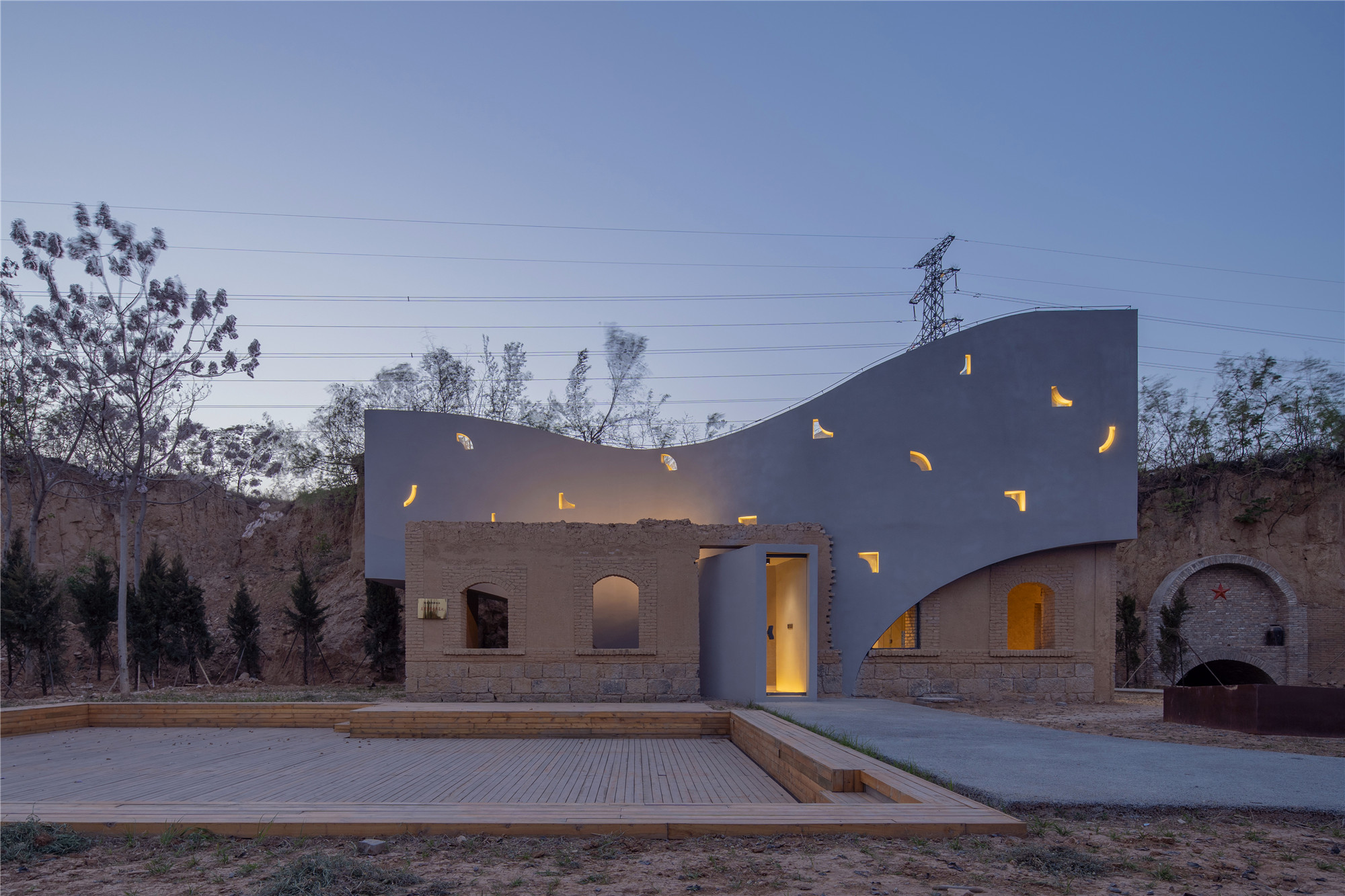
设计团队 一树建筑工作室
项目地点 河南焦作
建成时间 2020年9月
建筑面积 66平方米
最初,建筑师被委托在河南修武县设计一个300平米的文化建筑,来提升乡村社会的美学文化素养。然而考虑到630平方公里的县域面积和相距遥远的分散村落,建筑师提出将这个文化建筑单体分开成为一系列微型小品,可以更广泛地服务于社区的儿童,在日常开展丰富的活动。
In the beginning, the architect received the original commission to design a 300-square-meter public building for facilitating the county’s culture and art education in Xiuwu, Henan. However, considering the vast serving area (630-square-kilometer county area) and the difficulty of traveling between scattered villages, the architect came up with a proposal to divide one building into a series of miniature facilities in different locations so as to better serve local communities.


这些混凝土浇筑而成的微型建筑被设计成一系列带有触角的树状空间,向天空生长以获取光与影,他们有的坐落在田间、有的在树林中、有的从废弃的村庄残墙里生长出来、有的在水塘中营造一个漂浮的剧场。继第一个微建筑“桃屋”之后,第二个微建筑“废墟书屋”坐落于20公里外孙窑老村的一处土坯房残垣中。
These cast-in-place concrete miniatures are interpreted into a series of tree-shaped spaces with tentacles reaching out for the sky, bathing in light and shadow. Their locations vary from fields, woods, to mountaintops, and their forms differ as well: while one grows out from the ruined walls in an abandoned village, another embodies a floating theater on the water. Following the first completed "Peach Hut", the second episode of the miniature series, "Library in Ruins", is constructed alongside the remnant of an adobe house in Sunyao Old Village which is 20 kilometers away from the Peach Hut.



孙窑老村地处远离乡镇中心的山区,自1996年起,村民们陆续搬入隔壁砖混结构的新村房屋,于是留下老村许多日渐荒废的土坯旧屋和窑洞。现今场地周边起伏的远山、相邻处裸露的荒土崖壁及崖壁之上的广阔田野,展现出层次丰富的地形关系。
Sunyao Old Village is located in a mountainous area far away from the town center. Since 1996, villagers have moved into the brick-concrete houses in the new village next door one after another, leaving behind many aged adobe houses and cave dwellings. Years have passed, and when the abandoned village was examined by the architect, its surrounding undulating mountains, the barren cliffs adjacent to the site, and the vast fields above the cliffs all manifested rich topographical relationships that would evoke design inspirations.


村内提出利用原有宅基地范围内一处土坯墙废墟进行建设的想法,然而寻遍附近工匠,都找不到可以采用原有夯土工艺进行修筑的人。于是建筑师提出以新工艺方式在废墟中进行建造,让一个新生的构筑物从旧的废墟中长出来,让新建筑成为人们进入废墟,跃升过老屋,观看村庄、田野与远山的一个空间容器。
At first, the village asked the architect whether it was possible to build inside the plot of the original house where only a part of ruined adobe walls was left. However, after searching for nearby craftsmen, villagers were no longer able to find any craftsman who could build with the original rammed earth technique. Therefore, the architect proposed to build with a new method to allow a new structure to grow from the old ruins: allowing the new building to become a spatial device where people enter the ruins, jump over the old houses, and gaze into the village, the fields, and the mountains in the distance.




更进一步来讲,建筑师希望在书屋中呈现两重互相缠绕的记忆:一方面连接起窑洞、荒山、残墙,这些带着厚重质感与时间痕迹的遗存;一方面则延续微建筑系列的形态特点,顺应场地的形势而成为从地形中生长而出的雕塑式空间。两重线索彼此交插,残墙上原先门洞位置伸出一个混凝土体量的入口邀人进入;而进入建筑后,残墙一角伸入室内,引导人们沿着残墙痕迹去探索后方窑洞与荒山崖壁;在后院混凝土墙壁上,旧式木门被沿用下来,持续提示着新空间与旧物件之间的冲突与对话关系。
Furthermore, the architect hopes to present a duet of intertwined memories in this building: On the one hand, it connects cave dwellings, barren hills, and earth walls– physical remains with heavy texture and traces of time; On the other hand, it continues the formal languages of the miniature series while conforming to the context of the site to become a sculptural space that grows from the terrain. The two sets of memories spatially intersect each other: A concrete entrance protrudes out at the location of the original doorway on the remnant wall to invite people in; After entering the building, a corner of the remnant wall extends into the room, guiding people to explore the cave dwellings and the barren cliff in the rear garden; The traditional-style wooden doors are installed on the rear facade, continuously reminding visitors of the dialogues between the new space and the existing remnants.



建筑的外形与内部空间顺应地形的状态而展开。屋顶以起伏的轮廓呼应着地形与远山,而起伏地面在屋顶自然形成室外阶梯平台与滑梯。跃升过老屋的曲线剖面沟通起首层入口、二层阳台与屋顶平台。室内为可以兼作小型论坛放映室的阶梯图书馆 。建筑蜿蜒的平面及周边路径,则成为周遭迷宫般窑洞系统的延伸。
The facade and internal spaces of the building are unfolded in a topographic approach. The undulating outline of the roof echoes the terrain and distant mountains, and the roof ground naturally forms an outdoor terrace and a slide for children. The section curvature that jumps over the old walls links the first-floor entrance, the terrace, and the rooftop. The interior space functions not only as a stepped library, but also as a small projection room. The meandering plan of the building and the network of paths become an extension of the surrounding maze-like cave system.



书屋隐藏于村落建筑与树木的怀抱之中,四周茂密的树林与田园景象通过东西两侧大窗映射进屋内,南北两侧立面上预留了许多异形小窗洞,以呼应微建筑系列的建筑形态,希望以奇异的形状与光亮,为沉默的山村带去一些新能量——在白日里勾出奇异的阴影,在黑夜里又可以熠熠生辉。
The library is embraced in the open arms of the village buildings and trees. On the east and west facades of the building, large curtain windows are designed to greet the idyllic, leafy surroundings. The architect hopes to bring new energy to the silent village with interesting geometries and lighting. Many small special-shaped windows are cast with in-situ concrete on the north and south facades to echo the forms of buildings in the miniature series. These irregularly shaped openings curate a play of shadow during the day, and create a backdrop of twinkling lights throughout the night.




书屋于2020年9月建成后,附近包括孩子在内的村民们会常常来这里读书、休息和娱乐,这里也吸引了许多相邻县市的游客前来游玩。书屋入口处的小广场定期举办村民大会和乡村讨论会等社区活动,还曾作为2020年秋全国乡村复兴论坛·修武峰会的分会场使用,迎接来自全国各地的乡村振兴工作者们。与此同时,孙窑旧村也吸引了来自上海和郑州的网络直播公司前来修缮老屋、经营民宿并搭建网络平台,帮助老村连接起外面的世界。
After the library was completed in September 2020, nearby villagers and children often come here to read and play. It also attracts many tourists from neighboring counties and cities to the village. The small plaza in front of the building entrance regularly hosts community activities such as villagers' meetings and festivals. It was used as a sub-venue for the National Rural Revival Forum in the fall of 2020 to welcome rural revitalization practitioners from all over the country. At the same time, Sunyao Old Village attracted webcasting companies from Shanghai and Zhengzhou to come and renovate old houses as home-stay hotels, and they used webcasting platform to help the old village connect to the outside world.



设计图纸 ▽








完整项目信息
项目名称:微建筑系列II:废墟书屋
建成时间:2020年9月
建筑面积:66平方米
项目地址:河南省修武县七贤镇孙窑村
项目委托方:修武县政府
设计团队:一树建筑工作室
主持建筑师:陈曦
设计团队:朱静、田笛、黄家杰、王星瑶、许吕宝、王卫国、温维健、曹苏颖
施工图设计:李建辉(建筑) 粟志勐、黄小龙(结构) 甘彬、肖亮民(设备)
灯光设计:广州迈璟灯光设计有限公司
施工团队:河南元拓建设工程有限公司 + 修武县建筑公司
摄影:张超、一树建筑工作室
版权声明:本文由一树建筑工作室授权发布。欢迎转发,禁止以有方编辑版本转载。
投稿邮箱:media@archiposition.com
上一篇:IEW.H埃维纽上海旗舰店:反重力的时空之旅 / Kokaistudios
下一篇:新作 | 与山共生:莫干山郡安里“沁山”villa / 朱培栋